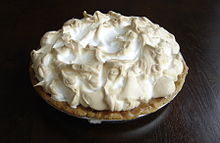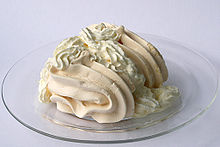meringue
Baiser (from French meringue , Kiss', pronounced "Besee" [ bɛzeː ]), also Spanish wind or meringue / Meringue is a meringue of sugared egg whites . Meringues are dried at around 100 ° C for one to two hours more than baked and should stay white to pale yellow. Meringue cakes, on the other hand, are only flamed, which means that the mixture remains rather soft and is slightly browned.
Manufacturing
According to the guiding principles for fine baked goods of the German food book , meringue is made from sucrose and / or other types of sugar and at least 20 percent chicken egg white by drying . If you acidify the whipped meringue with a little lemon juice , vinegar or tartar powder , it becomes stronger because the acid stabilizes the cross-linking of the proteins. The sugar content of a meringue mass can be between 50 and 110 g per egg white (30 g). One egg white can dissolve a maximum of 50 g of sugar, so the remaining sugar must be added in the form of powdered sugar or sugar boiled with water.
- Cold-beaten meringue: the egg white is beaten very stiffly, gradually adding powdered sugar (about 50 g per egg). If the mass is solid, put it in heaps or any other shape with a spoon or piping bag on a baking sheet lined with baking paper. Cold-whipped meringues are crumbly and porous, have a rough surface and are glossy.
- Warm whipped meringue: The preparation is essentially the same, but as soon as the egg white becomes stiff, the bowl is placed in a water bath heated to 50 ° C and the mixture is beaten until it is firm and fine-pored. The water bath must not come to a boil, otherwise the egg white will coagulate. Warm whipped meringue is much more stable than cold whipped meringue.
- Cooked meringue : (also called Italian meringue ) With this production method, hot sugar ( cooked at 114–116 ° C to fly a chain ) is lifted under the egg whites. This creates a meringue that is much more stable and, unlike cold-whipped meringues, also has a smooth and shiny surface.
The meringue mass disintegrates back to egg white within 10 to 20 minutes if it is not processed further.
use
Portion-sized meringues are usually hollowed out a little on the underside and filled in pairs with whipped cream and fruit as pavlova (named after the Russian ballet dancer Anna Pawlowna Pawlowa ) or with ice cream, fruit or cream and served.
Another variation with ice cream covered in meringue is the omelette surprise .
In Switzerland, classic meringues are only served with plenty of whipped cream . Meringue Glacé is the name of the dessert when it is also served with ice cream . Meringues are also widespread there as an accompaniment to vermicelles .

Meringue is also used as a top layer for cakes (mostly fruit cakes) and for gratinating desserts, although it does not completely dry out and browns slightly on the top. When gratinating ice cream in rare cases, only the outer shell or the shaped tips are browned. With some cakes , individual bases consist of pre-baked meringue, which may have been supplemented with ground nuts and a little flour (then also called japonaise ). A well-known example is the Zug cherry cake . Meringue is also an essential ingredient in a barbecue cake .
etymology
The foam pastry is called meringue in parts of southern Germany and outside of Germany . The origin of the name is unclear, either it goes back to Medieval Latin melinus 'honey sweet' or from Latin merenda ' snack , snack bread'. A folk etymological assumption is based on a connection with the place name of the Swiss community Meiringen , where the Italian confectioner Gasparini is said to have invented it around 1600. In addition to the French King Louis XV. the meringue was also tasted by the Queen of England. Their saying “Oh, that's like a kiss” is said to have led to the name meringue .
Similar dishes
- Salzburg dumplings are made in a similar way to meringue . However, they are not dried slowly, but baked.
- In Swabian , meringues are also known as Schäumle .
- In the Saxon-speaking area they are also known as Schmatzen .
literature
- Kurt Matheis: Patisserie. Masterful patisserie for hotel, pastry shop and restaurant in descriptions and recipes. 6th edition, Matthae, Stuttgart 1998, p. 136; 237. ISBN 3-87516-280-3 .
- Friedrich Holtz a. a .: Textbook of the pastry shop . 5th edition. Trauner, Linz 2009, ISBN 978-3-85499-367-4 , pp. 311 .
Web links
- Meringues in the database of Swiss culinary heritage
- Christoph Landolt : Meringue , in: Wortgeschichte from June 20, 2013, published by the editorial team of Schweizerischer Idiotikons .
Individual evidence
- ↑ Guidelines for Fine Baked Goods (PDF; 77 kB), accessed on November 8, 2013.
- ↑ America's Test Kitchen Guy Crosby: perfection [sic!]. The science of good cooking. Volume 3: Baking. Translated by Michael Schickenberg. Stiftung Warentest, Berlin 2016, ISBN 978-3-86851-431-5 .
- ↑ Friedrich Holtz a. a .: Textbook of the pastry shop . 5th edition. Trauner, Linz 2009, ISBN 978-3-85499-367-4 , pp. 311 .
- ↑ Erich Breiteneder et al .: Confectionery, patisserie, bakery. 3. Edition. Trauner, Linz 2008, ISBN 978-3-85487-589-5 .
- ↑ Christoph Landolt: Meringue , in: Wortgeschichte dated June 20, 2013, published by the editorial team of the Swiss Idiotikon
- ↑ Meringue - Description , on meiringen.ch


